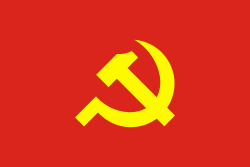Indochinese Communist Party
The Indochinese Communist Party (ICP; Vietnamese: Đảng Cộng sản Đông Dương, French: Parti Communiste Indochinois, Cantonese: 印度支那共產黨, Lao: ອິນດູຈີນພັກກອມມູນິດ, Khmer: គណបក្សកុម្មុយនីស្តឥណ្ឌូចិន) was a political party which was transformed from the old Vietnamese Communist Party (Vietnamese: Việt Nam Cộng sản Đảng) in October 1930. This party dissolved itself on 11 November 1945.
Indochinese Communist Party Parti Communiste Indochinois Đảng Cộng sản Đông Dương 印度支那共產黨 ອິນດູຈີນພັກກອມມູນິດ គណបក្សកុម្មុយនីស្តឥណ្ឌូចិន | |
|---|---|
 | |
| Founder | Ho Chi Minh |
| Founded | 3 February 1930 |
| Dissolved | 11 November 1945 |
| Succeeded by | CPV CPK LPRP |
| Ideology | Communism Marxism–Leninism Anti-colonialism |
| Political position | Far-left |
| International affiliation | Comintern |
| Colors | Red |
Background
The Vietnamese Communist Party was founded on 3 February 1930 by uniting the Communist Party of Indochina (despite its name, this party was active only in Tonkin) and the Communist Party of Annam (active only in Cochinchina). Thereafter, the Communist League of Indochina (active only in central Annam) joined the Vietnamese Communist Party. However, the Comintern argued that the communist movement should be promoted in the whole of French Indochina (including Cambodia, Laos and Vietnam) rather than only in Vietnam, therefore it urged the Vietnamese Communist Party to transform itself into the Indochinese Communist Party.[1]
League for National Salvation of Vietnamese Residents of Kampuchea
The League for National Salvation of Vietnamese Residents of Kampuchea was a pro-Viet Minh movement of Vietnamese inhabitants in Cambodia.
The organization emerged from a network of revolutionary committees formed among Vietnamese residents in the border areas of Cambodia towards the end of 1946.[2] Such groups had emerged in places like Takéo Province, Prey Veng Province and southern Kandal Province.[2] The League for National Salvation of Vietnamese Residents of Kampuchea was set up as a front organization of the Indochina Communist Party in March 1947, merging the various local revolutionary committees.[2][3] One of the first Viet Minh documents captured by the French in Cambodia was dated 30 April 1949 and revealed the existence of the League, as well as detailing a proposed Vietnamese-Khmer alliance against the French.[4][5][6]
In 1950, Vietnamese sources claimed the organization had a membership of 50,000.[7]
Transformation
In a resolution issued by the Vietnamese Communist Party in October 1930, the party criticized its own regulations and party name, with the resolution stating: "When naming the party "Vietnamese Communist Party", it implies that Cambodia and Laos are not concerned. Excluding these countries is a wrong thing because Annam, Cambodia and Laos should closely contact each other in terms of politics and economics even though they do not share a language, custom, and ethic". The party resolved "to give up the name "Vietnamese Communist Party" and to take the new name "Indochinese Communist Party".[8]
Later, the ICP issued a statement to explain the reason for changing its name. Noting the historical relationship between Vietnam, Laos and Cambodia, the flyer emphasized the need of a union of three countries to overthrow the French colonial regime in Indochina.[9]
Party activity program
The party program of action was based on 10 points:[10]
- To overthrow French imperialism and Vietnamese feudalism and reactionary bourgeoisie;
- To make Indochina completely independent;
- To establish a worker-peasant-soldier government;
- To confiscate the banks and other enterprises belonging to the imperialists and put them under the control of the worker-peasant-soldier government;
- To confiscate all the plantations and property belonging to the imperialists and the Vietnamese reactionary bourgeoisie and distribute them to the poor peasants;
- To implement the eight-hour working day;
- To abolish the forced buying of government bonds, the poll-tax and all unjust taxes hitting the poor;
- To bring democratic freedoms to the masses;
- To dispense education to all the people; and
- To realize equality between man and woman.
Dissolution
On 11 November 1945, the Indochinese Communist Party issued a communique to dissolve itself.[11] Later in 1951, the Vietnamese members of the party founded the Workers' Party of Vietnam and Cambodian members founded the Communist Party of Kampuchea. Four years later, Laotian members of the party founded the Lao People's Party.
References
- "Ho Chi Minh and the Communist Movement" Archived 16 April 2009 at the Wayback Machine.
- Stephen J. Morris (1999). Why Vietnam Invaded Cambodia: Political Culture and the Causes of War. Stanford University Press. p. 33. ISBN 978-0-8047-3049-5.
- UQAM. COMMITTEE FOR EXTERNAL AFFAIRS (Ban Ngoại Vụ)
- T. Smith (24 October 1960). "The Winds of Change, May 1948-January 1950". Britain and the Origins of the Vietnam War: UK Policy in Indo-China, 1943-50. p. 109. ISBN 9781349535347.
- Ben Kiernan (1981). "Origins of Khmer Communism". Southeast Asian Affairs: 161–180. JSTOR 27908428.
- Camille Scalabrino (1985). Cambodge: histoire et enjeux : 1945-1985. L'Harmattan. p. 83. ISBN 978-2-85802-671-5.
- Kiernan, Ben. How Pol Pot Came to Power. London: Verso, 1985. pp. 129–130
- "Án Nghị quyết của Trung ương toàn thể Đại hội nói về tình hình hiện tại ở Đông Dương và nhiệm vụ cần kíp của Đảng 10-1930". Archived 29 September 2011 at the Wayback Machine.
- "Truyền đơn giải thích việc đổi tên Đảng". Archived 29 September 2011 at the Wayback Machine.
- "Appeal Made on the Occasion of the Founding of the Indochinese Communist Party". Selected Writings of Ho Chi Minh (1920-1969). Marxists Internet Archive. Retrieved 2 February 2011.
- "Thông cáo Đảng Cộng sản Đông Dương tự ý giải tán, ngày 11-11-1945".